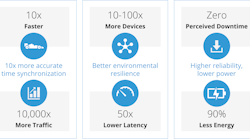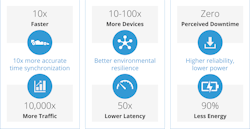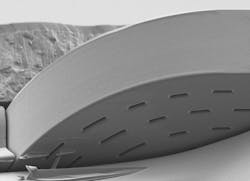Harsh Environments are Why Product Developers Should Rethink Timing for 5G
Not simply a faster 4G LTE, 5G is one of the most transformative technologies in the history of telecommunications. In fact, 5G is transforming industries, society and how we communicate and live. This is because 5G is 10 times faster than 4G, supports 10,000 times more network traffic, and can handle 100 times more devices, while enabling one-fiftieth the latency with zero perceived downtime.
Q: Have technological changes made is necessary to fully realize 5G capabilities?
A: Although 5G builds on existing 4G infrastructure, 5G networks deployed at scale will require a complete redesign of communications infrastructure. Industry experts generally agree it may take a decade to completely roll out 5G networks and to realize its full value through the Internet of Things (IoT), automated driving, telemedicine, artificial intelligence, and virtual and augmented reality. Leading carriers have already begun delivering 5G service in major metro areas this year, and we may see up to 1.8 billion 5G connections deployed worldwide by the end of 2021. One of the most important technologies enabling end-to-end 5G is MEMS timing.
Q: How does network densification lead to some harsh conditions for 5G deployments?
A: Network densification to add 5G network capacity requires adding more cell sites to a variety of locations in order to increase the amount of available capacity. To accomplish this, equipment is being deployed in uncontrolled environments, such as in basements, on rooftops, at curbsides and on poles.
A: Delivering on the full promise of 5G requires performance, bandwidth and latency beyond what’s possible with current networks. So far, we have deployed sub-6 GHz networks, and the market needs ultra-fast millimeter Wave (mmWave) technology in the 24 GHz to 40 GHz range. This shift will require widespread deployment of outdoor equipment to overcome line-of-sight, blockage, and coverage challenges associated with mmWave frequencies.
Two significant deployment requirements have emerged with 5G: network densification in which cell sites are added wherever they can be to increase the amount of available capacity and cloudification in which light and other utility poles are used to transform networks and enable 5G-powered services. Due to their exposure to shock, vibration, extreme temperatures and other harsh-environment stressors, these deployments require resilient, ruggedized timing components, and that means MEMS.
Q: Is rugged equipment required for 5G deployment?
A: Ensuring reliable, resilient 5G mmWave networks may require as much as 100x more equipment (base stations, small cells, relays and repeaters) deployed closer to customer premises such as on lampposts, traffic lights, stadiums, rooftops and exterior walls. Most of this equipment will operate in harsh outdoor environments and must withstand extreme temperatures, wind, vibration, and shock.
Q: What technologies do 5G implementations require?
A: The hardware and software technologies impacted by or involved in 5G implementations include, but are not limited to, optimized RF ICs, antenna arrays, amplifiers, beamforming and beam management techniques. At a recent operator-defined open and intelligent radio access networks (O-RAN) conference, the need for timing synchronization for 5G was a highly discussed topic. This is because many of the fundamental techniques involved in 5G not only require synchronization but, in fact, demand levels of timing alignment beyond anything previously deployed on this scale.
Q: Why are rugged timing devices so crucial for 5G deployments?
A: Timing devices are the heartbeat of all electronic systems including communications infrastructure, industrial equipment, automotive systems and countless electronics products. Think of a timing chip as a metronome used by a piano player, providing the musician with a precise, steady beat for a sharper, clearer musical performance. Despite the prevalence of timing technology in our lives, relatively few people—except for system engineers and architects—are aware of the crucial roles clocks and oscillators have played in communications revolutions over the past several decades. As we enter the 5G era, timing technology is more critical than ever.
Q: What are the different timing technologies in 5G? Why silicon-based MEMS?
A: Most electronic systems have historically used quartz-based timing devices, functionally similar to the quartz crystals quietly resonating inside our analog wristwatches. Quartz is a 70-year-old timing technology, and its resonators and oscillators have served us well over the decades. However, there’s a quiet revolution underway in the timing industry. New generations of timing devices based on tiny, ingenious micro-electromechanical systems (MEMS) resonators have been replacing quartz in applications that require the highest reliability and resilience to environmental stressors. MEMS technology, combined with analog circuits, provide a complete timing solution that is much smaller and lower power than equivalent quartz-based devices, and is much more resistant to harsh environmental conditions.
A: MEMS timing devices have been perfected over multiple generations and have steadily displaced quartz-based counterparts in many demanding communications and networking applications such as 4G LTE and 5G wireless infrastructure. MEMS-based resonators, oscillators and complete “clock-system-on-a-chip” devices deliver orders of magnitude higher performance, reliability and resilience than quartz solutions. For these reasons, MEMS is an ideal precision timing technology for 5G macro- and small-cell base stations deployed outdoors, helping equipment makers and mobile carriers deliver on the promise of 5G.
Q: Is 5G implementation worth the investment?
A: It is not an understatement to say that user experiences enabled by 5G can be life-changing. It is the next revolution in networked technology, not simply an evolutionary upgrade. Because of its revolutionary nature, 5G can enable entirely new, previously unattainable applications as it breaks boundaries in access, bandwidth, performance and latency to open up connectivity on massive scales for instantaneous, reliable communications in entertainment, healthcare, transportation, smart cities and homes, and the Internet of Things.
---------------------------
The success of 5G will depend in part on customer satisfaction, not only in terms of unrivaled wireless performance but also rock-solid reliability. With 5G, there is simply no option for dropped calls or network outages caused by extreme temperatures, excessive vibration or sudden shocks. Whether it’s for a self-driving car or remote surgery, operators and users alike must be able to rely on 5G as a failsafe technology. 5G equipment makers have already begun using MEMS-based timing technology in network infrastructure. In fact, more than 10 different 5G applications now use MEMS timing devices.
It’s about time: The 5G revolution is well underway, and the latest advances in MEMS timing technology will help energize the coming wireless network innovation and transformation.


